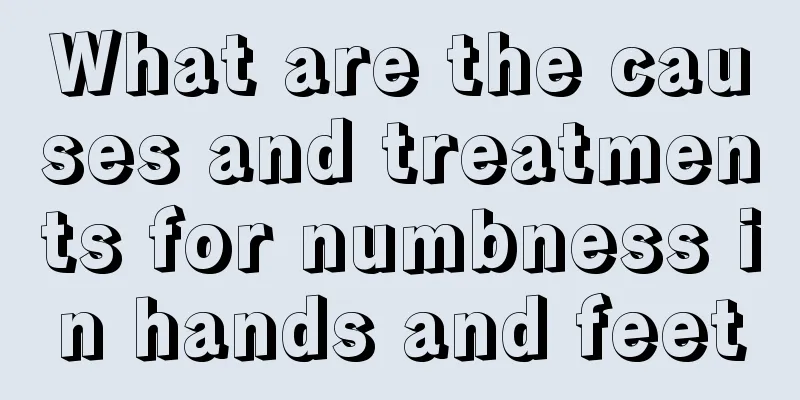What are the causes and treatments for numbness in hands and feet

|
In daily life, many people experience numbness in their hands or feet, but because it does not cause pain, it is often ignored. In fact, numbness in the hands and feet is a signal sent by the body to us, and we must pay enough attention to it. Only in this way can we avoid more serious diseases that endanger our health. Numbness in the hands and feet may be caused by neurological factors. Numbness in the upper limbs and legs requires caution against lumbar spondylosis, numbness in one hand may alert you to cervical spondylosis, and numbness and weakness in the fingers may be caused by carpal tunnel syndrome. People need to choose the appropriate treatment method based on their actual situation so that they can recover their health as soon as possible and get rid of the troubles of the disease. 1. The reasons behind numbness in hands and feet 1. Neurological factors The orange areas on the four hands in the above picture represent numbness. If the numbness in your hands is concentrated in the ring finger and little finger area, you can take a piece of paper and try to pinch it with your five fingers to test the strength of your five fingers; you can also push your five fingers outward to see if the strength is sufficient. If you are unable to hold the paper or the strength becomes weak, you should be alert to whether there is a problem with the ulnar nerve. The ulnar nerve is a nerve that passes through the elbow. Prolonged elbow flexion can easily compress the ulnar nerve, causing numbness in the hands, which can easily be confused with numbness in the hands caused by a stroke. If the numbness in your hands is concentrated in the thumb, index finger and middle finger areas, you can try to do this test: tap the middle point of the wrist crease of this hand (the middle of the wrist on the palm side) to see if there is an electric-like numbness that goes up to the fingertips. If so, it means that your hand numbness is likely related to damage to the median nerve and is not a manifestation of stroke. At this time, even if your CT scan shows lacunar infarction or brain lesions, do not ignore the problem of the median nerve. 2. Numbness in the upper limbs and legs may indicate lumbar spondylosis Numbness of hands and feet caused by lumbar spondylosis. It is numbness of upper limbs and legs caused by lumbar spondylosis. This scattered numbness of the limbs occurs when local nerves are stimulated, such as lumbar spondylosis, lumbar disc herniation, etc. Intervertebral disc compression of nerves can cause difficulty in movement and even incontinence. 3. Numbness in one hand may indicate cervical spondylosis. If numbness occurs on one side of the arm or fingers, it may be caused by cervical spondylosis, which is usually a chronic, recurring numbness accompanied by symptoms such as soreness and stiffness in the neck and shoulders. 4. Finger numbness or weakness or carpal tunnel syndrome Carpal tunnel syndrome refers to a disease characterized by thickening of the transverse carpal ligament, swelling of the tendons within the tunnel, tissue degeneration caused by congestion, or degeneration and hyperplasia of the carpal bones due to wrist trauma, fracture, dislocation, sprain or strain, which compresses the median nerve and causes numbness and weakness in the fingers. 5. Unilateral limb numbness may be a precursor to cerebral infarction. If numbness in the hands and feet occurs on one side while the other side is completely normal, you should be alert that it may be a precursor to cerebral infarction. Limb numbness caused by cerebral infarction is usually acute and may be accompanied by symptoms such as speech disorders and hemi-limb movement disorders, so in this case, you must seek emergency medical attention. 6. Symmetrical numbness should be prevented from diabetic lesions. Peripheral neuropathy caused by diabetes often presents with symmetrical pain and paresthesia, with symptoms in the lower limbs being more common than in the upper limbs. Sensory abnormalities include numbness, crawling ants, fever, and electric shock-like sensations, which often spread from the distal toes to above the knees. Patients have sensory abnormalities like wearing socks and gloves. 7. If you experience persistent numbness and pain, be careful of a tumor. If elderly people experience long-term chronic numbness in their hands and feet that persists and does not improve, it may be caused by a malignant tumor. In the late stage of the tumor, due to the influence of the remote site effect, corresponding neurological symptoms will occur, such as numbness and weakness in the hands and feet, and unsteady walking. Therefore, if the common causes are not found, a comprehensive examination must be conducted, such as the liver, stomach, blood, etc. Women need to pay special attention to the ovaries and breasts. So as to detect tumors as early as possible and treat them in time. 2. What diseases can cause numbness in hands and feet? 1. Arteriosclerosis The characteristics of numbness are mostly numbness of one upper limb or lower limb or half of the body, which usually lasts for several hours to several days. If not treated in time, it will develop into hemiplegia and paralysis. 2. Carpal tunnel syndrome The limb numbness caused by this disease is characterized by numbness that worsens when the wrist is flexed. Carpal tunnel syndrome is caused by wrist strain and other reasons, which lead to thickening of the transverse carpal ligament, swelling of the tendons in the carpal tunnel, congestion causing tissue degeneration, or degeneration and hyperplasia of the carpal bones causing the circumference of the canal to decrease, thereby compressing the median nerve, causing numbness and weakness in the fingers, and the symptoms progressively worsen. It is common in middle-aged women who do more housework such as mopping the floor and washing clothes. 3. Cervical spondylosis It is the most common disease that causes numbness in the fingers and is also one of the diseases that are common among middle-aged and elderly people. In recent years, the disease has tended to occur in younger people. Due to long-term sitting and unwillingness to move, abnormal neck posture, especially prolonged use of computers and mobile phones, the cervical intervertebral discs undergo degenerative changes, leading to disc herniation or hyperplasia or hypertrophy of the articular processes. Once these protruding cervical discs or hyperplastic articular processes compress the adjacent cervical nerve roots and blood vessels, numbness of the arms and fingers will occur. This numbness is usually chronic and recurrent, accompanied by soreness, stiffness and other discomforts in the neck and shoulders. Numbness in one arm or finger may be caused by cervical spondylosis, which can be easily caused by long-term work with the head down, cold neck, or too high a pillow. 4. Lumbar disc herniation Most patients will experience numbness in the lower limbs, usually manifested as chronic, recurrent unilateral or bilateral numbness in the thighs, calves, and feet, accompanied by symptoms such as pain and discomfort in the lower back. Long-term heavy physical labor, strenuous exercise, history of trauma, smoking, cold, poor posture, etc. can easily cause lumbar disease. The patient can be diagnosed through X-rays, CT scans or MRI scans. 5. Transient ischemic attack If numbness of the hands and feet occurs on one side while the other side is normal, it may be caused by transient ischemic attack (TIA). Cerebral ischemia can easily develop into cerebral infarction. Therefore, middle-aged and elderly people with three highs or carotid artery sclerosis and plaque formation should pay special attention to this kind of numbness of the hands and feet. Limb numbness caused by cerebral ischemia or cerebral infarction is usually acute and may be accompanied by symptoms such as speech disorders and hemi-limb movement disorders. This type of numbness should be treated immediately. 6. Diabetes Bilateral symmetric numbness in the fingers is a common symptom of diabetic peripheral neuropathy. Diabetic peripheral neuropathy is a common complication of diabetes. Many diabetic patients have poor blood sugar control and will develop complications early. Measure blood sugar regularly and visit the endocrinology department promptly if you have any related symptoms. Elderly people are likely to suffer from indigestion and insufficient nutrition, which can lead to peripheral neuritis due to vitamin B1 deficiency. Also, since diabetes can cause multiple complications, people with numbness in their hands may also have diabetes. 7. Gout Clinically, about 1% of patients with hand numbness suffer from gout, which may be caused by uric acid deposited in the median nerve, compressing the median nerve and causing numbness and pain in the hands. Since there are many people smoking and drinking in today's society, for those who drink frequently, if they drink too much, it will cause numbness in their hands. This is because you are already suffering from chronic alcohol poisoning. 3. How to effectively relieve numbness in hands and feet? Here are some quick ways to relieve numbness in your hands and feet: Numbness of hands and feet is actually called arthralgia in the category of diseases. It is an important signal of wind, cold, dampness, and evil toxic gas invading the body. Before the evil toxic gas invades the internal organs, the professional feeling is numbness of hands and feet, soreness, heaviness, pain, and tingling in the limbs. This is a signal of blocked meridians and it is also the body's last line of defense. Massage can help speed up blood circulation, dredge blocked areas and improve treatment. Moxibustion can also improve the effect of meridians in dispelling cold. Pat gently Beat gently, and the strength should be within the level that you can accept. Bath and foot soak You can soak your feet in hot water before going to bed to improve blood circulation. In addition to daily observation and finger movements, we also need to seek medical attention and treatment in a timely manner, otherwise the meridians will be damaged, thus destroying the human nerve conduction function system, causing nerve necrosis, and eventually causing stroke, hemiplegia, myocardial infarction, cerebral infarction, diabetic gangrene, and lifelong regrets... People who are middle-aged or older, especially those who are obese, should take active measures to prevent stroke if they experience numbness in their index finger, middle finger or the root of the tongue. Patients with numbness in hands and feet due to rheumatic bone disease should pay attention to keeping warm and avoiding moisture, especially keeping warm. Excessive coldness, chills, or severe cold weather will often aggravate the symptoms of numbness. Of course, most people’s numbness in their hands and feet is simply due to poor blood circulation caused by compression of nerves. If the numbness in your hands and feet persists for more than a day and does not subside, or if it occurs suddenly and is accompanied by other symptoms, it is recommended that you go to the neurology department of a hospital for prompt treatment. First of all, patients with numbness in hands and feet should pay attention to keeping a regular schedule. Secondly, eat in moderation, especially avoid overeating fatty and greasy foods, to prevent "three highs" blood diseases. In addition, patients with numbness in hands and feet should maintain a happy mood and avoid worry and anger. |
<<: Malignant tumor on the kidney, you need to know these
>>: How should acute periodontitis be treated?
Recommend
What are the benefits of eyebrow massage
Eyebrows are a very important part of the human b...
What time is the best to drink honey water at night
Many people know that the nutritional value of ho...
What are the postoperative care measures for cardiac cancer?
Surgical treatment of cardiac cancer is the first...
How to drain menstrual blood during menstruation?
Generally speaking, a woman's menstrual perio...
What's wrong with my eye frame hurting
The eyes are the bridge that connects us to the o...
What is the basis for the diagnosis of bile duct cancer
What is the basis for the diagnosis of bile duct ...
Is esophageal cancer inherited by males or females?
Is esophageal cancer a family disease? Is esophag...
What are the special drugs for esophageal cancer
Esophageal cancer is one of the malignant tumors ...
What to do if the skin is sunburned
People's skin cannot be exposed to the sun be...
Can I do cupping on a rainy day?
Nowadays, many people know that they should maint...
The benefits of negative oxygen ions to the human body
You all know that in recent years, with the devel...
What should I pay attention to in my diet after cervical cancer surgery?
With the progress of the times, people's livi...
Why does thyroid cancer cause vomiting of blood after eating?
Thyroid cancer patients vomit blood after eating,...
How to prevent and treat glioma
Gliomas are one of the common intracranial tumors...
How to get rid of the hot pot smell on your body?
When the weather is cold, you can invite some fri...









